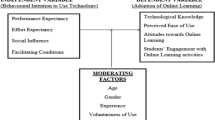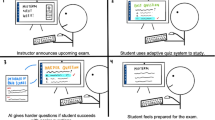Abstract
Many approaches, models and frameworks exist when designing quality online learning environments. These approaches assist and guide instructional designers through the process of analysis, design, development, implementation and evaluation of instructional processes. Some of these frameworks are concerned with student participation, some with motivation and some with student success. All these variables affect active participation and engagement of the student to some degree but the main concern is how to design online instruction conducive to high level of engagement. Therefore, this paper presents an instructional design framework along with a set of strategies that could be used to foster learner engagement in online learning. This framework is result of an extensive literature review on student engagement and is aimed at summarizing the results in a cohesive way for online instructors. For e-learning design and development to be successful online designers and instructors need better approaches to increasing student engagement and its authors hope that proposed framework provides such an approach.





Similar content being viewed by others
References
Artino, A. R. (2010). Online or face-to-face learning? Exploring the personal factors that predict students' choice of instructional format. The Internet and Higher Education, 13(4), 272–276.
Artino, A. R., & Stephens, J. M. (2009). Academic motivation and self-regulation: A comparative analysis of undergraduate and graduate students learning online. The Internet and Higher Education, 12(3–4), 146–151.
Bakia, M., Jones, K., Means, B., Murphy, R., & Toyama, Y. (2010). U.S. Department of Education, Office of Planning, Evaluation, and Policy Development, evaluation of evidence-based practices in online learning: A meta-analysis and review of online learning studies. Washington, DC: US Department of Education. Retrieved from http://www.ed.gov/about/offices/list/opepd/ppss/reports.html.
Carina, R. M., Kuh, G. D., & Klein, S. P. (2006). Student engagement and student learning: Testing the linkages. Research in Higher Education, 47(1), 1–32.
Chen, P. D., Lambert, A. D., & Guidry, K. R. (2010). Engaging online learners: The impact of web-based learning technology on college student engagement. Computers & Education, 54, 1222–1232.
Chen, W.-C. (2014). Actual and preferred teacher feedback on student blog writing. Australasian Journal of Educational Technology, 30(4), 402–414.
Coates, H. (2007). A model of online and general campus based student engagement. Assessment & Evaluation in Higher Education, 32(2), 121–141. doi:10.1080/02602930600801878.
Collins, A., Brown, J. S., & Newman, S. E. (1987). Cognitive apprenticeship: Teaching the craft of reading, writing and mathematics (Technical Report No. 403). BBN Laboratories. Cambridge: Centre for the Study of Reading, University of Illinois. January, 1987.
Dixon, M. D. (2010). Creating effective student engagement in online courses: What do students find engaging? Journal of the Scholarship of Teaching and Learning, 10(2), 1–13.
Durrington, V. A., Berryhill, A., & Swafford, J. (2006). Strategies for enhancing student interactivity in an online environment. College Teaching, 54(1), 190–193.
Garrison, D., Anderson, T., & Archer, W. (2000). Critical inquiry in a text-based environment: Computer conferencing in higher education. The Internet and Higher Education, 2, 87–105.
Holley, D., & Oliver, M. (2010). Student engagement and blended learning: Portraits of risk. Computers & Education, 54, 693–700.
Hrastinski, S. (2008). What is online learner participation? A literature review. Computers & Education, 51(4), 1755–1765.
Hrastinski, S. (2009). A theory of online learning as online participation. Computers & Education, 52(1), 78–82.
Hu, S., & Kuh, G. D. (2001). Computing experience and good practices in undergraduate education: Does the degree of campus wiredness matter? Paper presented at the Annual Meeting of the American Educational Research Association. Seattle: ERIC Database: ED 452 775. Retrieved from http://files.eric.ed.gov/fulltext/ED452775.pdf.
Jonassen, D. H., Peck, K. L., & Wilson, B. G. (1999). Learning With Technology: A Constructivist Perspective. Upper Saddle River: Prentice-Hall.
Larson, M. B., & Lockee, B. B. (2014). Streamlined ID: A practical guide to instructional design. New York: Routledge.
Laurillard, D. (2002). Rethinking university teaching. A conversational framework for the effective use of learning technologies. London: Routledge.
Lave, J., & Wenger, E. (1991). Situated learning. Legitimate peripheral participation. Cambridge: University of Cambridge Press.
Lee, J., & Jang, S. (2014). A methodological framework for instructional design model development: Critical dimensions and synthesized procedures. Education Technology Research and Development, 62(6), 743–765. doi:10.1007/s11423-014-9352-7.
Leeds, E., Campbell, S., Baker, H., Ali, R., Brawley, D., & Crisp, J. (2013). The impact of student retention strategies: An empirical study. International Journal of Management in Education, 7(1–2), 22–43.
Lim, D. H., Morris, M. L., & Kupritz, V. W. (2007). Online vs. blended learning: Differences in instructional outcomes and learner satisfaction. Journal of Asynchronous Learning Networks, 11(2), 27–42.
Morrison, G. R., Ross, S. M., Kalman, H. K., & Kemp, J. E. (2011). Designing effective instruction (6th ed.). Hoboken: Wiley.
National Survey of Student Engagement. (2013). A fresh look at student engagement: Annual results 2013. Bloomington: Indiana University Center for Postsecondary Research. Retrieved from http://nsse.iub.edu/NSSE_2013_Results/pdf/NSSE_2013_Annual_Results.pdf.
National Survey of Student Engagement. (2014). Bringing the institution into focus—Annual results 2014. Bloomington: Indiana University Center for Postsecondary Research. Retrieved from http://nsse.indiana.edu/NSSE_2014_Results/pdf/NSSE_2014_Annual_Results.pdf.
Nelson Laird, T. F., & Kuh, G. D. (2005). Student experiences with information technology and their relationship to other aspects of student engagement. Research in Higher Education, 46(2), 211–233.
Parsons, J., & Taylor, L. (2011). Student engagement: What do we know and what should we do? University of Alberta. Canada: University Partners. Retrieved from http://education.alberta.ca/media/6459431/student_engagement_literature_review_2011.pdf.
Pike, G. R., Kuh, G. D., & McCormick, A. C. (2011). An investigation of the contingent relationships between learning community participation and student engagement. Research in Higher Education, 52(3), 300–322.
Porter, S. (2006). Institutional structures and student engagement. Research in Higher Education, 47(5), 521–558.
Richey, R. C., Klein, J. D., & Tracey, M. W. (2011). The instructional design knowledge base: The theory, research, and practice. New York: Routledge.
Robinson, C. C., & Hullinger, H. (2008). New benchmarks in higher education: Student engagement in online learning. Journal of Education for Business, 84(2), 101–109. doi:10.3200/JOEB.84.2.101-109.
Roubides, P. (2004). E-Learning through effective facilitation. In J. Nall & R. Robson (Eds.), Proceedings of World Conference on E-Learning in Corporate, Government, Healthcare, and Higher Education 2004 (pp. 1689–1693). Chesapeake: Association for the Advancement of Computing in Education (AACE).
Saadé, R. G., He, X., & Kira, D. (2007). Exploring dimensions to online learning. Computers in Human Behavior, 23(4), 1721–1739.
Trowler, V. (2010). Student engagement literature review. The Higher Education Academy: Lancaster University. Retrieved from http://www.new2.heacademy.ac.uk/assets/documents/studentengagement/StudentEngagementLiteratureReview.pdf.
Wang, Y., & Chen, D. (2010). Promoting spontaneous facilitation in online discussions: Designing object and ground rules. Educational Media International, 47(3), 247–262.
Weil, S., McGuigan, N., & Kern, T. (2011). The usage of an online discussion forum for the facilitation of casebased learning in an intermediate accounting course: A New Zealand case. Open Learning, 26(3), 237–251.
Author information
Authors and Affiliations
Corresponding author
Rights and permissions
About this article
Cite this article
Czerkawski, B.C., Lyman, E.W. An Instructional Design Framework for Fostering Student Engagement in Online Learning Environments. TechTrends 60, 532–539 (2016). https://doi.org/10.1007/s11528-016-0110-z
Published:
Issue Date:
DOI: https://doi.org/10.1007/s11528-016-0110-z




